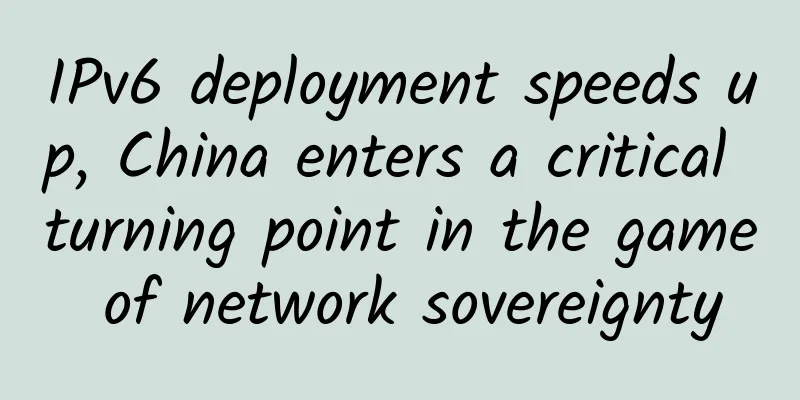IPv6 deployment speeds up, China enters a critical turning point in the game of network sovereignty

|
Cai Yiqun told reporters that the deployment of IPv6 still has a difficulty, which is that it requires multiple roles such as equipment manufacturers, operators, and application providers to work in sync. For example, if only operators support IPv6, but computers, mobile phones, or websites visited by users do not support it, it will be meaningless. In the development of the Internet, the TCP/IP protocol is an important cornerstone. Among them, IP is a network layer protocol, which can regulate the exchange and routing of packet information in the Internet. Currently, the fourth version of the IP protocol IPv4 is mainly used in the market. However, IPv4 addresses are 32 bits long, with a total of only about 4.3 billion. According to Wu Hequan, an academician of the Chinese Academy of Engineering, as early as 2011, the global supply of new IPv4 addresses had been exhausted. IPv6 is the sixth version of the IP address protocol. Its biggest advantage is that the address length is designed to be 128 bits, which can provide 2 to the 128th power IP addresses. It is no exaggeration to say that the number of IPv6 addresses is so large that it can assign an address to every grain of sand on the earth. Therefore, a wave of IPv6 replacing IPv4 is sweeping the world. Wu Hequan also said that IPv6 is an insurmountable stage in the development of the Internet. After years of research and development, the global deployment of IPv6 has accelerated in recent years, and the Internet will enter the IPv6 era. In this process, Chinese companies are not far behind. On June 20, Alibaba Cloud, together with China Telecom, China Unicom, China Mobile, and China Education Network, announced that it would provide IPv6 services to the public and hoped to achieve "IPv6 Only" by 2025.
China's critical turning point In an interview with a reporter from 21st Century Business Herald, Cai Yiqun, vice president of Alibaba Group, said that although China was one of the earliest countries to carry out IPv6 trials, the proportion of IPv6 terminals in China is now far behind that of advanced international countries. Statistics show that the IPv6 deployment rate in the United States, Germany, Belgium, India and other countries has approached or exceeded 40%. At the same time, IPv6 terminals account for 18% of all terminals worldwide, while China only accounts for 0.5%. India, also a large developing country, has 57% of IPv6 terminals, and the total number of terminals accounts for half of the world's IPv6 terminal devices. In addition, according to statistics from the Asia-Pacific Network Information Center (APNIC) as of the end of November 2017, India's IPv6 users reached 220.7 million, ranking second in the world in terms of penetration rate. China has only 5 million IPv6 users, accounting for only 0.7% of the country's more than 700 million Internet users. Wu Hequan said that there are many reasons for the relatively slow deployment of IPv6 in China, such as falling into the trap of private addresses, lack of clear market orientation and government application-first awareness, insufficient attention to content service bottlenecks and lack of effective policy measures, and some misunderstandings that have affected the implementation of the country's IPv6 development strategy. However, these problems were solved at the end of last year. On November 26, 2017, the General Office of the CPC Central Committee and the General Office of the State Council issued the "Action Plan for Promoting the Large-Scale Deployment of Internet Protocol Version 6 (IPv6)", proposing to form an independent technology system and industrial ecology for the next generation of the Internet and build the world's largest IPv6 commercial application network in 5 to 10 years. The plan also points out that by the end of 2020, the number of active IPv6 users in China will exceed 500 million, accounting for more than 50% of Internet users, and new network addresses will no longer use private IPv4 addresses; by the end of 2025, China's IPv6 network scale, user scale, and traffic scale will rank first in the world, and the network, applications, and terminals will fully support IPv6, completing a smooth evolution and upgrade to the next generation of the Internet. In May this year, the Ministry of Industry and Information Technology issued a notice on the implementation of the "Action Plan for Promoting the Large-Scale Deployment of Internet Protocol Version 6 (IPv6)", which proposes to implement the IPv6 action plan in six aspects. It is proposed that by the end of 2018, the top 10 cloud service platforms must complete 50% of cloud product transformation, and the number of mobile Internet IPv6 users nationwide must be no less than 50 million households. Wu Hequan said that this technological innovation will be a key turning point for China to compete for network sovereignty. With the deployment of IPv6, China will be able to participate in the operation of the Internet and the organization and allocation of key resources. "There are more than 8,000 standards for the international Internet. In the IPv4 era, China only proposed the Chinese encoding standard. But in the IPv6 era, China started at the same time as developed countries and proposed more than 100 standards for IPv6. It can be said that IPv6 has opened up a new innovation space for the development of China's Internet." Multi-party collaboration to deploy IPv6 The introduction of national policies will play an important role in promoting the development of IPv6. The Action Plan has clear requirements for operators, application vendors, and even national ministries and local government websites. Industry experts pointed out that the most critical issue now is how to implement these requirements. Cai Yiqun told reporters that the deployment of IPv6 still has a difficulty, which is that it requires the coordination of multiple roles such as equipment manufacturers, operators, and application providers. For example, if only operators support IPv6, but computers, mobile phones, or websites visited by users do not support it, it will be meaningless. "A complete IPv6 from application, end to pipe and cloud requires the joint efforts of all walks of life. Therefore, Alibaba Cloud has launched in-depth cooperation with China Telecom, China Mobile, China Unicom and China Education Network in the hope of achieving a comprehensive connection of 'cloud-pipe-end' so that users' terminal devices, operator networks and cloud applications can support IPv6 at the same time." Cai Yiqun said. According to the reporter, in addition to having a huge IP address space, IPv6 actually has many advantages that IPv4 cannot match. For example, it does not require manual configuration or address allocation services such as DHCP, making management more convenient; the IPv6 protocol comes with IPSec design, making it safer for enterprises to use and less likely to be intercepted and tampered with. However, enterprises will face difficulties such as long renovation period, high technical difficulty and uncontrollable quality if they upgrade to IPv6 by themselves. From network infrastructure to gateway, control and application level, enterprises need to redesign and rebuild the technology stack from scratch, and ensure business continuity and stability in the process. These problems often become obstacles to the development of IPv6. Wu Hequan said that when promoting the IPv6 action plan, many of the target groups are traditional industries, which have no idea how to transform to IPv6. This is actually an opportunity for Internet companies. Service providers including Alibaba Cloud will become an important driving force for IPv6. The reporter learned that since the global IPv6 network was officially launched in 2012, Alibaba has started to select equipment for IPv6 network research and development. At present, Alibaba Cloud has completed 6PE, NAT64, and IPv6 upgrade route transformation from inside to outside by using self-developed technologies such as AliGBP, AliPing, Netframe, and AliGuard in the process of fully deploying IPv6. The IPv6 high-speed forwarding can reach up to 400G, which is 2.5 times the industry's commercial performance. Cai Yiqun revealed that currently, Alibaba Cloud's cloud products such as SLB, DNS, CDN, and DDoS protection all support IPv6, and OSS and RDS will soon support IPv6. In the second phase, Alibaba Cloud's ECS and VPC products will provide IPv6 services. Wu Hequan pointed out that IPv6 is a historical opportunity for accelerating innovation and reform of global network information technology and rapidly evolving and upgrading information infrastructure. China has made early preparations and has accumulated a lot of foundations and conditions in many aspects. We must seize this opportunity, respond to challenges with innovation, accelerate the large-scale deployment of IPv6, and build a high-speed, intelligent next-generation Internet. |
<<: Unlimited traffic ≠ unlimited traffic usage. Have you ever encountered this kind of "trap"?
>>: About NSA and SA of 5G, you will understand it in seconds after reading this!
Recommend
Wi-Fi Alliance wants to simplify the numbering and use numbers instead of "802.11ac"
If you've ever bought a Wi-Fi router, you pro...
How to ensure consistency of Serverless business deployment updates?
Since I started working on Serverless tools, I of...
5G is a hot topic, but 4G module application data is still rising
According to the latest data released by the Mini...
Popularize knowledge! 20 key 5G technologies
5G network technology is mainly divided into thre...
HostKvm newly launched China Unicom CUVIP line VPS, 1G memory package starts at $5.2/month after 20% discount
Recently, more and more merchants have connected ...
In the 5G era, telecom operators need to strengthen their independent R&D team building
No matter which century it is, talent is always t...
Virtono offers 30% off down payment for all VPS, 27 data centers in Japan/Singapore/Hong Kong/USA/UK etc.
Virtono recently released a 30% discount code for...
RackNerd: San Jose AMD Ryzen+DDR4+NVMe series KVM starts at $14.18 per year
Previously, we have shared information about the ...
5G deployment plan postponed to 2021, will operators agree?
In 2020, the sudden outbreak of COVID-19 is havin...
In response to the five major trends of application modernization in the financial industry, consistent delivery experience is the key
With the rapid development of digital technology,...
Webman uses RabbitMQ messaging middleware to implement system asynchronous decoupling practical tutorial
Introduction RabbitMQ is an open source message b...
Guangzhou Hongfang Zhou Jiaxing: Ruijie system engineer's growth story of "upgrading and fighting monsters"
Zhou Jiaxing, Director of the Authorized Service ...
How 5G can help realize massive IoT
When discussing the coming 5G era, attention is o...
Maxthon Host: Germany CU2 low latency large bandwidth 20% off, 2GB memory package monthly payment 60 yuan
Maxthon Hosting has been very low-key for a long ...
Using data to speak, Hubo Technology helps improve college students' critical thinking and research capabilities
Recently, in order to enrich product functions an...









